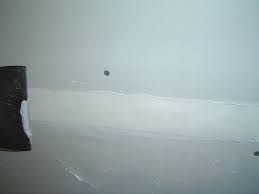Step-by-Step Instructions on Finishing Drywall
By Mark J. Donovan
|
|
Though many drywall finishers swear they are the only ones capable of doing an excellent drywall finish job, I beg to differ. Yes it may take the do it yourself homeowner a little longer to complete a drywall finishing project, and yes there maybe some initial growing pains, however with a little upfront knowledge most homeowners can finish drywall.
Key to finishing drywall, aka taping and mudding drywall, is having the right tools and material. It is important to have both narrow and wide drywall blades, a mud pan, drywall tape, joint compound, mask, goggles, and a pole sander with drywall sandpaper. You may also want a corner drywall blade, however they take some time getting use to, and you normally can do corners just as well with a narrow drywall blade. |
Besides having the right tools and material it is also important for the drywall to be installed properly. Check to make sure that all drywall nails or screws are secured properly into the wall studs and are not protruding beyond the surface of the drywall. As a matter of fact, they should be nailed or screwed into the drywall such that they create a slight dimple in the drywall paper surface.
Make sure you first fill the seams and corners with joint compound. Also apply a skim coat of joint compound to either side of the seam or corner, approximately 2-3 inches wide, so that you can smooth the drywall tape into it with your taping knife. Make sure you center the drywall tape over the seam or corners.
Cover the drywall tape with a skim coat layer of joint compound. In addition, cover each nail or screw hole with a small dab of joint compound using your small taping knife. And with that, your first step in finishing drywall is complete. Allow the joint compound to dry thoroughly before moving on.
After applying the first coat of drywall joint compound, apply a second coat over the first layer of joint compound using the wider drywall taping knife. Again, let the joint compound thoroughly dry.
| Next apply a final coat of drywall to the seams and nail holes flaring out the seam even wider with your wide taping knife.
Once the final coat of joint compound has thoroughly dried use your drywall pole sander and sandpaper to lightly sand over the joint compound seams and nail patches. Make sure to sand mostly around the edges of the drywall seams and patches, leaving a slight high spot directly over the seams and nail/screw areas. Make sure you wear a mask and goggles when sanding, as dust flies everywhere. |
 |
After finishing the drywall, you can then prime and paint the walls. Again, learning how to finish drywall upfront, and having the right tools, are the two key ingredients in ensuring a professional finish drywall project.
For information on repairing a large drywall hole, see the “How to Repair a Large Drywall Hole” Ebook from HomeAdditionPlus.com. The “How to Repair a Large Drywall Hole” Ebook provides step-by-step instructions on how to repair your damaged wall so that it looks as good as new.
See HomeAdditionPlus.com’s Drywall Calculator
Related Information
Additional Drywall Installation Resources from Amazon.com
 |
 |
Free Home Addition Price Quotes with No Obligation!
Fill out our 3-5 minute quick and easy form, and receive a free price quote on a house addition from one of our prescreened and licensed home addition contractors. This process is free and there is no obligation to continue once you receive your house addition price estimate.

